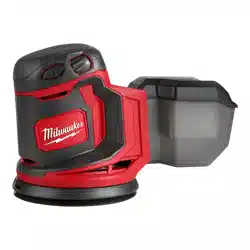Loading ...
Loading ...
Loading ...

6
OPERATION
WARNING
To reduce the risk of injury, always
remove battery pack before chang-
ing or removing accessories or making adjust-
ments. Only use accessories specically recom-
mended for this tool. Others may be hazardous.
Always wear proper eye protection marked to
comply with ANSI Z87.1.
When working in dusty situations, wear appro-
priate respiratory protection or use an OSHA
compliant dust extraction solution.
Starting and Stopping the Tool
To start the sander, press the ON (I) button.
To stop sander, press the OFF (O) button.
Speed Dial
The speed dial allows the sander to operate at vari-
able speeds - from low speed (1) to high speed (6).
1. To increase sanding disc speed, turn the dial to
a higher setting.
2. To decrease sanding disc speed, turn the dial to
a lower setting.
WARNING
Finish sanding can produce clouds
of ne dust that could ignite in the
presence of sparks or open ame. Always wear
a suitable dust mask or respirator and use your
sander in a well-ventilated area.
To reduce the risk of injury, inspect for and
remove all raised nails and fasteners from work-
piece before sanding. Striking a fastener while
sanding could cause loss of control.
General Sanding with Random Orbit Sanders
When using random orbit sanders there are a few
things to keep in mind:
• Unlike most sanders, random orbit sanders should
be placed on the workpiece BEFORE the tool is
started. If the sander is started before it is placed
on the workpiece, the free oating pad may be spin-
ning at a speed that can cause scratches when it is
nally placed on workpiece.
• Unlike most sanders, random orbit sanders can be
moved across the workpiece in any direction (in
the case of wood, regardless of the direction of the
grain).
• Varying pressure applied to the sander will aect
its rotating speed. A light pressure is recommended
for ne work, moderate pressure for rough work.
Excessive pressure does not allow the pad to rotate
enough.
• Keep sanding pad at on the workpiece. Tipping the
sander or using the edges of the pad may produce
an uneven nish, and reduce pad life.
• Keep sander moving in broad even strokes across
the workpiece. Sanding in one spot too long can
cause gouging and uneven results.
• Check the workpiece frequently, random orbit sanders
work more aggressively than simple orbital sanders.
WARNING
Properly secure workpiece before
sanding. Unsecured work could be
thrown towards the operator causing injury.
To reduce the risk of injury, do not wear loose
clothing or jewelry when operating sander. They
could get caught in moving parts causing serious
injury. Keep head away from sander and sanding
area. Hair could be drawn into sander causing
serious injury.
1. Place sander on the workpiece and turn on the
sander.
2. Keep the sanding disc at against the workpiece,
keep the sander moving across the workpiece,
and use long, sweeping strokes.
3. Begin sanding with a coarse grit sandpaper and
gradually use ner and ner grits of sandpaper un-
til the desired nish is reached. For example when
using the sander on wood, begin with an 80 grit
followed by a 120 grit, then a 180 grit and so on.
Removing Paint or Varnish
1. When removing several layers of paint or varnish,
remove as much as possible with a paint solvent
or varnish remover.
2. Scrape away the residue with a putty knife or other
scraping tool and allow the surface to cool and dry
before applying sander to the workpiece.
WARNING
To reduce the risk of re and explo-
sion, paint solvents and varnish
removers must be removed from the workpiece
and the workpiece must be completely dry before
sanding.
3. Select a coarse grit sandpaper disc to help prevent
the sandpaper from clogging.
4. Keep the sander moving over new areas to avoid heat-
ing and softening the old coating (paint or varnish).
5. Work in wide, overlapping strokes to produce a
uniform nish.
6. As the workpiece begins to show through the old
coating, switch to a medium grit sandpaper disc
to avoid scratching the surface of the workpiece.
Gradually switch to a ne grit sandpaper until you
achieve the desired nish.
Loading ...
Loading ...
Loading ...
